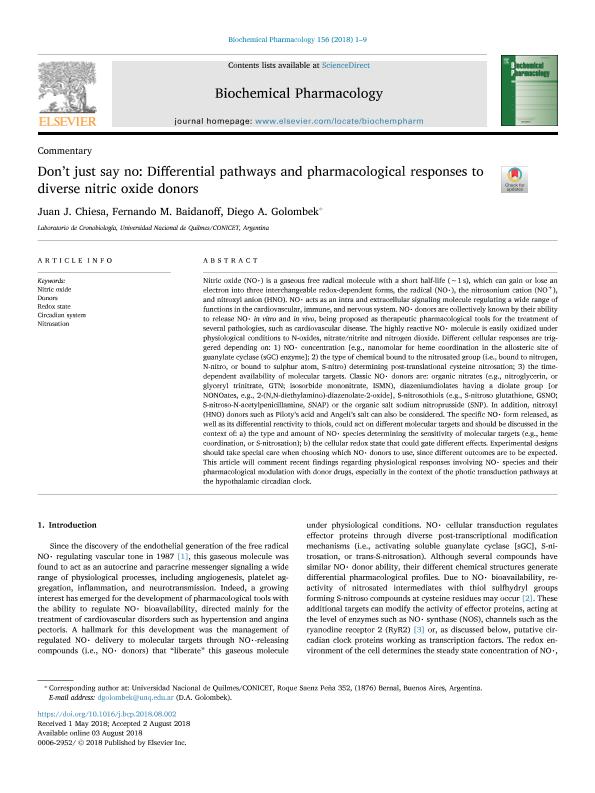Mostrar el registro sencillo del ítem
dc.contributor.author
Chiesa, Juan José

dc.contributor.author
Baidanoff, Fernando Martín

dc.contributor.author
Golombek, Diego Andrés

dc.date.available
2020-02-20T22:01:47Z
dc.date.issued
2018-10
dc.identifier.citation
Chiesa, Juan José; Baidanoff, Fernando Martín; Golombek, Diego Andrés; Don't just say no: Differential pathways and pharmacological responses to diverse nitric oxide donors; Pergamon-Elsevier Science Ltd; Biochemical Pharmacology; 156; 10-2018; 1-9
dc.identifier.issn
0006-2952
dc.identifier.uri
http://hdl.handle.net/11336/98224
dc.description.abstract
Nitric oxide (NO[rad]) is a gaseous free radical molecule with a short half-life (∼1 s), which can gain or lose an electron into three interchangeable redox-dependent forms, the radical (NO[rad]), the nitrosonium cation (NO+), and nitroxyl anion (HNO). NO[rad] acts as an intra and extracellular signaling molecule regulating a wide range of functions in the cardiovascular, immune, and nervous system. NO[rad] donors are collectively known by their ability to release NO[rad] in vitro and in vivo, being proposed as therapeutic pharmacological tools for the treatment of several pathologies, such as cardiovascular disease. The highly reactive NO[rad] molecule is easily oxidized under physiological conditions to N-oxides, nitrate/nitrite and nitrogen dioxide. Different cellular responses are triggered depending on: 1) NO[rad] concentration [e.g., nanomolar for heme coordination in the allosteric site of guanylate cyclase (sGC) enzyme]; 2) the type of chemical bound to the nitrosated group (i.e., bound to nitrogen, N-nitro, or bound to sulphur atom, S-nitro) determining post-translational cysteine nitrosation; 3) the time-dependent availability of molecular targets. Classic NO[rad] donors are: organic nitrates (e.g., nitroglycerin, or glyceryl trinitrate, GTN; isosorbide mononitrate, ISMN), diazeniumdiolates having a diolate group [or NONOates, e.g., 2-(N,N-diethylamino)-diazenolate-2-oxide], S-nitrosothiols (e.g., S-nitroso glutathione, GSNO; S-nitroso-N-acetylpenicillamine, SNAP) or the organic salt sodium nitroprusside (SNP). In addition, nitroxyl (HNO) donors such as Piloty's acid and Angeli's salt can also be considered. The specific NO[rad] form released, as well as its differential reactivity to thiols, could act on different molecular targets and should be discussed in the context of: a) the type and amount of NO[rad] species determining the sensitivity of molecular targets (e.g., heme coordination, or S-nitrosation); b) the cellular redox state that could gate different effects. Experimental designs should take special care when choosing which NO[rad] donors to use, since different outcomes are to be expected. This article will comment recent findings regarding physiological responses involving NO[rad] species and their pharmacological modulation with donor drugs, especially in the context of the photic transduction pathways at the hypothalamic circadian clock.
dc.format
application/pdf
dc.language.iso
eng
dc.publisher
Pergamon-Elsevier Science Ltd

dc.rights
info:eu-repo/semantics/openAccess
dc.rights.uri
https://creativecommons.org/licenses/by-nc-sa/2.5/ar/
dc.subject
CIRCADIAN SYSTEM
dc.subject
DONORS
dc.subject
NITRIC OXIDE
dc.subject
NITROSATION
dc.subject
REDOX STATE
dc.subject.classification
Bioquímica y Biología Molecular

dc.subject.classification
Ciencias Biológicas

dc.subject.classification
CIENCIAS NATURALES Y EXACTAS

dc.title
Don't just say no: Differential pathways and pharmacological responses to diverse nitric oxide donors
dc.type
info:eu-repo/semantics/article
dc.type
info:ar-repo/semantics/artículo
dc.type
info:eu-repo/semantics/publishedVersion
dc.date.updated
2020-02-18T16:07:35Z
dc.journal.volume
156
dc.journal.pagination
1-9
dc.journal.pais
Estados Unidos

dc.description.fil
Fil: Chiesa, Juan José. Consejo Nacional de Investigaciones Científicas y Técnicas; Argentina. Universidad Nacional de Quilmes. Departamento de Ciencia y Tecnología. Laboratorio de Cronobiología; Argentina
dc.description.fil
Fil: Baidanoff, Fernando Martín. Universidad Nacional de Quilmes. Departamento de Ciencia y Tecnología. Laboratorio de Cronobiología; Argentina. Consejo Nacional de Investigaciones Científicas y Técnicas; Argentina
dc.description.fil
Fil: Golombek, Diego Andrés. Universidad Nacional de Quilmes. Departamento de Ciencia y Tecnología. Laboratorio de Cronobiología; Argentina. Consejo Nacional de Investigaciones Científicas y Técnicas; Argentina
dc.journal.title
Biochemical Pharmacology

dc.relation.alternativeid
info:eu-repo/semantics/altIdentifier/url/https://www.sciencedirect.com/science/article/pii/S0006295218303216
dc.relation.alternativeid
info:eu-repo/semantics/altIdentifier/doi/http://dx.doi.org/10.1016/j.bcp.2018.08.002
Archivos asociados
